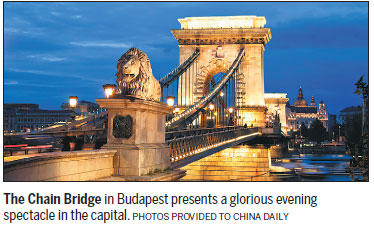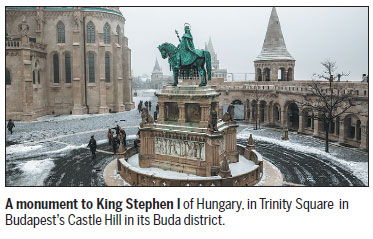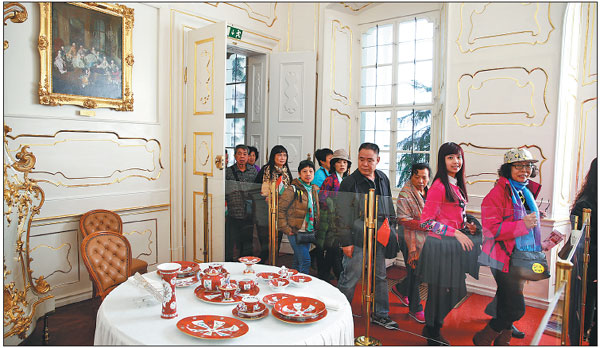Nation's special mix of magic entrances
Rich, cultural country offers raft of intoxicating delights
"Liberty and love These two I must have. For my love I'll sacrifice My life. For liberty I'll sacrifice My love."
You may have read or even heard these ringing and stirring sentiments and may even know they were penned by poet Petofi Sandor.
You may not, however, necessarily know where he came from.
Sandor is from a proud and ancient nation which boasts eight UNESCO World Heritage sites and has been inscribed on the UNESCO List of the Intangible Cultural Heritage of Humanity.
It is also a country at the crossroads of Europe, but different to the continent in many ways. It has a wealth of culture and history, complemented by a language so different from its neighbors.
Petofi, in short, is a national hero and poetic giant from Hungary, a country many people only describe in superlatives.
Hungary has 10 million inhabitants within its 93,030-square-kilometer territory. It is landlocked like its neighbors Austria, Slovakia and Serbia.
Nevertheless, it deserves its nickname "land of waters" because it is also home to Central Europe's largest lake, Lake Balaton.
Additionally, the famed river Danube splits its capital city Budapest into Buda on the western side and Pest on the eastern bank.
Centering on the both banks of the Danube, Budapest is a city of full of surprises and wonder, abundant with sightseeing spots and tourist attractions.
Some 50 meters above the Danube in the center of Budapest, sits the unmistakable Buda castle hill. It is actually a district itself and comprises multiple attractions, such as the Fisherman's Bastion, the President's Residence as well as the Royal Palace.
The Royal Palace, an enormous edifice at the southern end of castle hill, was constructed in the 14th century, then rebuilt 400 years later and had major reconstruction after World War II. It now houses the national gallery and the Budapest history museum.
The Fisherman's Bastion is often the first stop for tourists visiting Budapest, the fairy turrets offering an elevated vantage point from which to view the city. The minarets and walls look medieval, but were actually built in 1902 by Frigyes Schulek to complement Matyas Church, a tall and steepled catholic church that is part of the distinctive skyline of Budapest's castle district.
On the eastern bank of the Danube is the world's second-biggest parliament building, a postcard favorite, particularly when reflected in the river beneath it.
Construction of this 96-meter-high structure took 19 years. More than 40 million kilos of gold were used for decoration; inside there are 27 gates and 29 staircases.
Andrassy Avenue, named after the 19th-century prime minister who has did much to make Budapest a true metropolis, is an elegant thoroughfare comparable with Paris's Champs Elysees.
One of the special features of Andrassy Avenue are the iron balustrades leading underground. Europe's first sub-surface railway was built under the road, and the more than 125-year-old subway is still carrying passengers today.
Particularly worth mentioning are the bridges connecting Buda and Pest, the capital's two halves split by the Danube River, running through the city from north to south.
The Chain Bridge is the most popular and oldest one. Its full name is Szechenyi Chain Bridge, referring to Count Istvan Szechenyi, who ordered the building of a permanent bridge on the Danube.
The suspension bridge is 375 meters long. The construction lasted from 1840 to 1849. It is on the list of UNESCO World Heritage sites and is the No 1 and most used symbol of Budapest.
At night, the old bridge shines brightly like a diamond necklace, with proud guardian lions watching your every step.
Margaret is the second oldest bridge of the capital city. It's 607 meters long and was fully renovated between 2009 and 2011. Between this bridge and Arpad Bridge is Margaret Island, a grass-laden recreational oasis on the Danube which features among other things a musical fountain, a small zoo, jogging tracks, thermal spas and swimming pools.
Petofi Bridge is named after one of the greatest Hungarian poets, Petofi Sandor. It is 378 meters long and was opened to the public in 1937. From this bridge, visitors can catch an amazing view to the Gellert Hill, the Buda Castle and the Elisabeth Bridge.
In sharp contrast to the capital, Lake Balaton is a tranquil destination for tourists to relax and rest.
They can indulge in the smooth waters and fresh wines, sand and surf, splashing and sailing, concerts and clubs, elegant castles and sleepy villages, beautiful landscapes and clean air.
At the western edge of the lake, visitors can not only find a source of health in the largest natural medicinal thermal water lake in the world, but also one of the three greatest baroque palaces in the country, Festetics Palace.
Wine
The southern shores of Lake Balaton lull visitors with their quiet, undemonstrative charm. The small towns, living traditions of arts and crafts, spas and wineries, exquisite castle hotels, complete the visitors' trip to the waters.
The story of wine is inseparable from the history of nations and Hungary is no exception. Wine was introduced to the country by the Romans, and was renowned for its excellent wines until the devastation of World War II.
Today Hungary has 22 designated wine regions. Its Tokaji, famously dubbed the wine of the kings, is one of the world's finest dessert wines with its intense color and distinctive range of flavors.
Benefiting from the Belt and Road Initiative, Hungary has been becoming increasingly popular among the countries involved in the initiative.
According to the data released by Hungarian government, in August 2017, Hungary's hotel accommodation revenue hit 37 billion forint ($139 million), experiencing year-on-year growth of 16 percent.
Total revenue from the catering industry hit 9 billion forint, for year-on-year growth of 13 percent.


|
Chinese tourists pay a visit to a Hungarian nobelman's sumptuous palace in the township of Pecs.Xinhua |
(China Daily 11/28/2017 page18)















